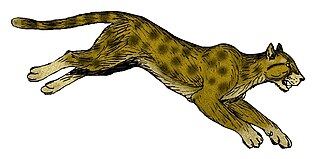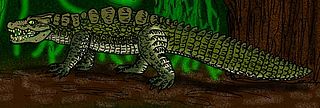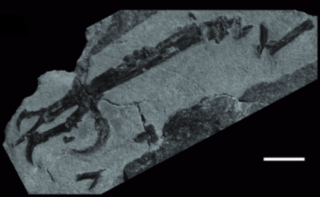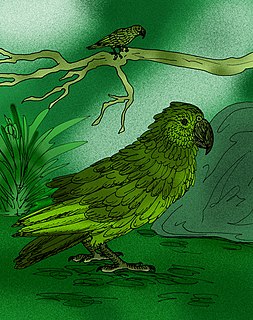Related Research Articles

Plestiodon inexpectatus, the southeastern five-lined skink is a common skink in the southeastern United States.

The American cheetah is either of two feline species of the extinct genus Miracinonyx, endemic to North America during the Pleistocene epoch and morphologically similar to the modern cheetah. These cats were originally known from fragments of skeletons, but nearly complete skeletons have been recovered from Natural Trap Cave in northern Wyoming.

Trilophosuchus is an extinct genus of mekosuchine crocodilian from Australia. Unlike living crocodilians, it is hypothesized to have been terrestrial. Trilophosuchus was approximately 1.5 metres (4.9 ft) in length. It had a short skull with three ridges on top and large eyes. Fossils have been found at Riversleigh in north-western Queensland, and are Miocene in age. Only a single species has been described, the type species T. rackhami.
Aellen's pipistrelle is a species of vesper bat. It can be found in possibly Benin, Cameroon, Ghana, Nigeria, and Sierra Leone. It is found in dry and moist savanna.
Phrynobatrachus inexpectatus is a species of frog in the family Phrynobatrachidae. It is endemic to southern Ethiopia. It is known with confidence from only three localities, but it may be more widely distributed in the Ethiopian Highlands. The specific name inexpectatus refers to the unexpected discovery of this species among museum specimens assigned to Phrynobatrachus minutus. Common names unexpected puddle frog and Largen's dwarf puddle frog have been coined for it.

The marbled frogmouth is a bird in the family Podargidae. The species was first described by Jean René Constant Quoy and Joseph Paul Gaimard in 1830. It is found in the Aru Islands, New Guinea and Queensland. Its natural habitats are subtropical or tropical moist lowland forest and subtropical or tropical moist montane forest.

The Stephen's Island gecko, also known commonly as the Cook Strait striped gecko, Stephen's sticky-toed gecko, and the striped gecko, is a species of gecko in the genus Toropuku in the family Diplodactylidae. The species is endemic to New Zealand.

The crested roundleaf bat is a species of bat in the family Hipposideridae. It is endemic to Indonesia.
Eurotrochilus is a genus of extinct members of the stem group Trochilidae and are the closest relatives of the crown group Trochilidae, which includes modern hummingbirds. Despite Eurotrochilus having looked very similar to modern hummingbirds, they still retained several primitive features and are not closely related to any specific extant hummingbird in the crown group. There are currently two discovered species of Eurotrochilus: E. inexpectatus and E. noniewiczi.

Lazarussuchus is an extinct genus of amphibious reptile, known from the Cenozoic of Europe. It is the youngest known member of Choristodera, an extinct order of aquatic reptiles that first appeared in the Middle Jurassic. Fossils have been found in Late Paleocene, Late Oligocene, Early Miocene and Late Miocene deposits in France, Germany, and the Czech Republic. Two species have been named: the type species L. inexpectatus ("unexpected") from the late Oligocene of France. and L. dvoraki from the early Miocene of the Czech Republic. It was not a large animal; the skull of L. inexpectatus was only about 4.53 centimeters long (1.78 in), with the total preserved body and tail length being just over 30 centimetres. A complete specimen of Lazarussuchus with preserved soft tissue was found from the Late Paleocene of France, but has not been assigned to a species.
Schizodactylus inexspectatus is a species of dune cricket (Schizodactylidae) endemic to sand dunes of Çukurova and Göksu Deltas, Turkey.

Intiornis is an extinct genus of avisaurid enantiornithean birds which existed in what is now North-West Argentina during the late Cretaceous period.

Onciderini is a tribe of longhorn beetles of the subfamily Lamiinae, they are prevalent across Europe in nations such as Turkey, and Finland.
Psyllotoxus is a genus of longhorn beetles of the subfamily Lamiinae, containing the following species:
Monochamus inexpectatus is a species of beetle in the family Cerambycidae. It was described by Stephan von Breuning in 1935.
Psyllotoxus griseocinctus is a species of beetle in the family Cerambycidae. It was described by James Thomson in 1868. It is known from French Guinea and Brazil.
Dierogekko inexpectatus also known as Key New Caledonian Gecko is a gecko endemic to Grande Terre in New Caledonia.
The Dar-es-Salaam dwarf gecko is a species of gecko endemic to Tanzania.

Heracles inexpectatus is a giant fossil parrot species from New Zealand, assigned to a monotypic genus Heracles, that lived during the early Miocene approximately 16 to 19 million years ago. The species was described from fossils discovered in 2008 at Saint Bathans, Otago, New Zealand. It is believed that the species stood up to 1 m tall and weighed approximately 7 kg (15 lb). Initial analysis suggests it is from the superfamily Strigopoidea, which consists of three confirmed genera of parrots: Nestor, Strigops (kakapo) and the fossil Nelepsittacus. It may have been the ancestor of the kakapo.
Anolis inexpectatus, the pineland bush anole, is a species of lizard in the family Dactyloidae. The species is found in Cuba.
References
- ↑ BioLib.cz - Psyllotoxus inexpectatus. Retrieved on 8 September 2014.